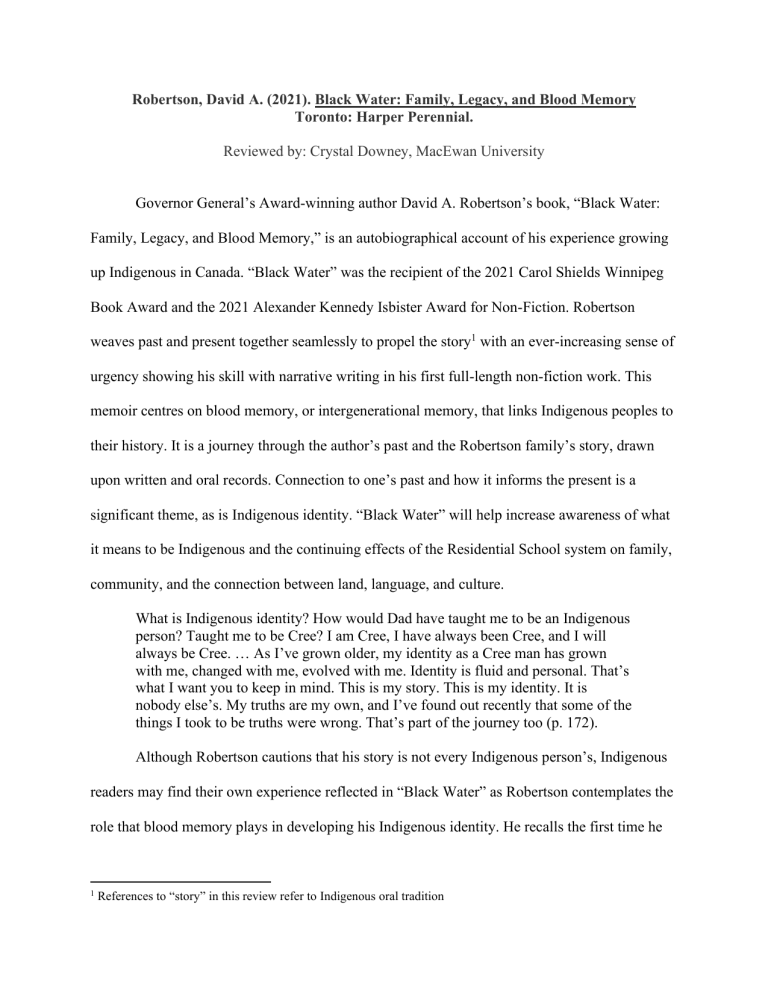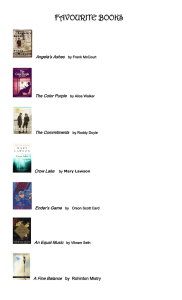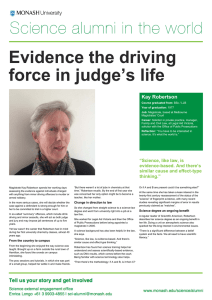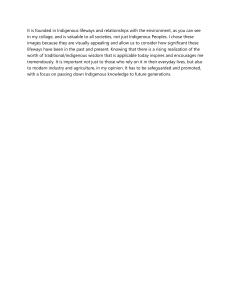Black Water Book Review: Indigenous Identity & Legacy
advertisement

Robertson, David A. (2021). Black Water: Family, Legacy, and Blood Memory Toronto: Harper Perennial. Reviewed by: Crystal Downey, MacEwan University Governor General’s Award-winning author David A. Robertson’s book, “Black Water: Family, Legacy, and Blood Memory,” is an autobiographical account of his experience growing up Indigenous in Canada. “Black Water” was the recipient of the 2021 Carol Shields Winnipeg Book Award and the 2021 Alexander Kennedy Isbister Award for Non-Fiction. Robertson weaves past and present together seamlessly to propel the story1 with an ever-increasing sense of urgency showing his skill with narrative writing in his first full-length non-fiction work. This memoir centres on blood memory, or intergenerational memory, that links Indigenous peoples to their history. It is a journey through the author’s past and the Robertson family’s story, drawn upon written and oral records. Connection to one’s past and how it informs the present is a significant theme, as is Indigenous identity. “Black Water” will help increase awareness of what it means to be Indigenous and the continuing effects of the Residential School system on family, community, and the connection between land, language, and culture. What is Indigenous identity? How would Dad have taught me to be an Indigenous person? Taught me to be Cree? I am Cree, I have always been Cree, and I will always be Cree. … As I’ve grown older, my identity as a Cree man has grown with me, changed with me, evolved with me. Identity is fluid and personal. That’s what I want you to keep in mind. This is my story. This is my identity. It is nobody else’s. My truths are my own, and I’ve found out recently that some of the things I took to be truths were wrong. That’s part of the journey too (p. 172). Although Robertson cautions that his story is not every Indigenous person’s, Indigenous readers may find their own experience reflected in “Black Water” as Robertson contemplates the role that blood memory plays in developing his Indigenous identity. He recalls the first time he 1 References to “story” in this review refer to Indigenous oral tradition stepped foot in Norway House and immediately felt at home; “an Elder told me … that the feeling of familiarity was called blood memory, and that Norway House … had always been a part of me (p. 25).” Robertson conveys the persistent sense that something was missing from his life (p. 169) and believes it was his blood memory inviting him to return to his ancestors’ traditional lands. He relates how his daughter, Lauren, had a similar homecoming experience out at Black Water (p. 262-263). Robertson’s father, Don, credits the resilience of the people of Norway House, stored in his blood memory, with giving him the strength to adapt to so many changes after he left his small community (p. 131). As Robertson puts it, “the memories and lives of our ancestors are woven into the fabric of [our] DNA (p. 263).” Robertson does not shy away from the existence of Canada’s Residential School system or the intergenerational effects it continues to have on Indigenous peoples. The information is contained mainly in Chapter Four, prefaced with a cautionary trigger warning to survivors. Robertson emphasizes that the circumstances of each Residential School survivor were different and that even one child experiencing abuse was one child too many (p. 70). Due to the spotty record keeping or destruction of records throughout the Residential School system, physical evidence can be challenging to obtain. Many family histories were lost to time, as some survivors never unveiled their truths before they passed away (p. 64). Although Robertson did find some records related to his family, he also relies on the oral history of his maternal Grandmother, Nana, his father, Don, and other extended family and community members. The stories included are poignant and truthful and paint a picture of what Residential School was like for the children forced to attend. Robertson shares that although Nana did not reveal too much about her time in Residential School, knowing the stories of her classmates and uncovering sporadic school records about attendance and living conditions helps him envision what it might have been. As he stands on the old foundation of the school Nana attended, he can see her in his mind’s eye (p. 63). Indigenous people come to terms with missing details, as records and voices might vanish over time, but blood memory ensures that their ancestors’ experiences are always within them. As Indigenous peoples across Canada continue to experience intergenerational trauma, Robertson addresses how powerful sharing their truth can be in Residential School survivors healing journey (p. 64). The act of remembering is a way to heal by reconciling the present with the past. He proposes that we cannot know ourselves without knowing the lives of those who came before (p. 62). However, Don cautions Robertson that “our story … isn’t a residential school story. …That history is a part of our family, and it always will be. But there is more to us … (p. 72).” Robertson’s chronicle allows future generations of Indigenous peoples to connect with this dark history for healing and for non-Indigenous folks to learn the lasting impacts of the Residential School program. By unearthing his personal history, Robertson ensures the continuation of his family’s stories. Oral tradition was the method of passing down knowledge and history. However, forced removal from connection to land, language, and culture means that what remains of this history will be lost unless recorded in new ways. He says that because his father did not tell these stories to his children as would have happened in past generations, Don “talks … in the language of lost memories … in pieces that he tries to connect but cannot (p. 147).” Returning to the physical place of Black Water facilitated memory recall through visual input. Robertson describes his father taking inventory of the area, “breathing in the memories like air (p. 254).” The mundane events Don recalls suddenly become seminal moments in history (p. 255). Through collecting his dad’s stories, Robertson can take his children to Black Water and tell them, “This was a gathering place for our family (p. 262).” “Black Water” will assist non-Indigenous readers in understanding the complicated decisions Indigenous families face in childrearing. Robertson’s father never intended to deny their Indigenous heritage. To Don, indigeneity is, so he believed that through observing him living a good life, his children would find their version of Indigenous identity (p. 171-172). However, Robertson expresses that since his father was not around for most of his childhood, harmful stereotypes usurped the idea of indigeneity his father intended him to observe, leaving him confused and ashamed (p. 179). Indigenous children forced into Residential Schools never had the opportunity to learn parenting skills from their community because they were not in the community long enough to absorb them. A choice taken away from most Indigenous parents was teaching the children their language. Since Residential Schools punished children for speaking a language other than English, it stole an essential part of their identity; it was an act of cultural genocide (p. 140). Robertson’s dad regrets not teaching his sons to speak Cree (p. 146). Don had always spoken Cree with his family, but after he attended seminary school, his mother told him, “Your Cree was so bad (p. 140)!” At that moment, Don realized “the weight of what he had lost (p. 138).” The “words that held all the knowledge [he had] learned as a child on the trapline (p. 140)” were slow to return as he worked to recover his language. When Robertson’s daughter, Lauren, asks her Moshum (Grandpa), to teach her Cree (p. 245), it encapsulates how much was lost and what is required to reclaim it. Robertson’s “Black Water” is captivating. While some readers may find the flashback style confusing, I felt a compelling sense of urgency building as the past caught up to the present on the physical and metaphorical journey to Black Water. His chronology illustrates how we can connect the past to the present and asks, “How did we get to today?” Robertson regrets not having enough time with his father to learn everything Don had to teach him (p. 266). “Intergenerational trauma requires … purposefully working towards healing through the connections we choose to foster, [and] the things we seek to learn. … [T]ypically, … this learning happens through Elders[’] … stories, and happens through the language (p. 248).” Although the book is accessible for anyone wishing to learn more about the history of Indigenous peoples in Canada, I would recommend it for many academic disciplines, including psychology, anthropology, sociology, social work, and education. The memoir addresses the history and intergenerational effects of the Indian Act, Residential Schools, and more. It illuminates Indigenous peoples’ struggles in the aftermath of these events and the hope that lies in reconciliation. Word Count: 1484





